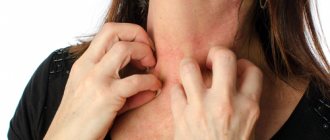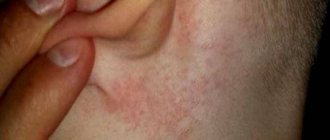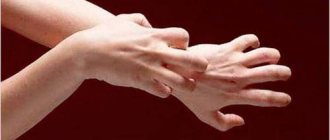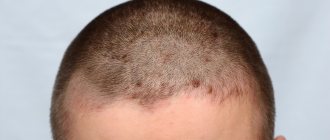You are in the section: Home » Articles » DERMATOLOGY: inguinal athlete's foot (dermatomycosis)
Review
Athlete's foot (also known as tinea inguinalis, eczema fringe, ringworm, Tinea cruris, etc.) is a fungal infection of the trichophytosis class caused by Trichophyton, Microsporum and Epidermophyton fungi that affects the skin of the groin area, including the genitals, inner thighs and buttocks.
Skin lesions manifest themselves in the form of an itchy red, often ring-shaped rash, predominantly located in the warmest and most humid areas of the human body that are constantly covered by clothing. Tinea groin is common in people who sweat a lot, such as athletes. It is also more common in overweight people.
This disease, as a rule, is not serious, although it causes a lot of inconvenience to its carriers. For cure, it is usually sufficient to maintain hygiene of the groin area and use local antifungal drugs.
Symptoms
Fringed eczema usually begins as a red patch of skin that spreads from a crescent-shaped crease in the groin to the upper thigh. The border of the rash may consist of a line of small blisters. The rash often itches or burns, and the skin may peel or become scaly. This, by the way, is where the names groin itching or lichen come from.
When to see a doctor
Call your doctor if you have a skin rash that does not go away on its own within two weeks, or if it appears again within a few weeks of finishing over-the-counter medications.
Causes
Athlete's foot is caused by fungi that can be spread from person to person through direct contact or by sharing contaminated towels or clothing. Tinea cruris in athletes is often caused by the same fungus that infects the feet and causes athlete's foot (Tinea pedis). Usually in these cases the infection is transferred from the foot to the groin folds through the hands or wet towels.
Risk factors
Microorganisms that cause itching in the groin prefer the moist environment of skin folds and hidden places of the human body. Those most at risk are:
- men;
- teenagers or young adults;
- lovers of wearing tight underwear;
- are overweight;
- sweating heavily;
- having a weakened immune system;
- susceptible to diabetes (excessive urination in diabetes insipidus).
Prevention
To reduce your risk of developing athlete's foot, simply follow these principles:
Maintain good body hygiene . It is important to keep the groin area clean and dry. Dry the genital area and inner thighs thoroughly after showering with a clean, ironed towel. To prevent diaper rash, use powder in the groin area.
Wear clean clothes . If you sweat a lot, change your underwear at least once a day or more often. Wash your workout clothes after each use.
Choose clothes that fit . Make sure clothes fit your body, especially underwear and sportswear. Avoid tight-fitting clothing, which can chafe and itch your skin. Try wearing boxer shorts instead of briefs and trunks.
Don't share personal items . Do not allow others to share your clothing, towels, or other personal items. And do not take these items from others yourself.
Treatment of athlete's foot . Control foot infections to prevent them from spreading higher into the groin area. If you frequently visit public places, such as gym showers, public saunas and steam baths, wearing sandals will help prevent athlete's foot infection.
Diagnostics
In most cases, diagnosing tinea groin is not difficult. To determine the disease, simply look at the rash. If the diagnosis is not clear, the doctor may take skin scrapings or samples from the affected area and examine them under a microscope. To rule out other pathologies, your doctor will likely send the sample to a laboratory for culture.
Treatment
For mild tinea groin, your doctor may suggest using an over-the-counter antifungal ointment, lotion, powder, or spray first. With these treatments, the rash may disappear fairly quickly, but you must continue to use the drug as directed for one to two weeks. If tinea pedis is also detected, it is necessary to treat both of these diseases simultaneously. An integrated approach will significantly reduce the risk of relapse.
For severe ringworm or a form of the disease that is resistant to over-the-counter medications, prescription creams or ointments or even antifungal tablets may be needed.
Treatment of severe inguinal athlete's foot, complicated by tinea pedis or other underlying disease, as well as the consequences of self-medication, can take a long time and require a certain amount of patience from the patient. However, it is not incurable and is quite successfully treated by experienced dermatologists at the Clinic of Dr. Filatov.
1.General information
Itching is an extremely unpleasant skin reaction; if it “itches”, it is impossible to concentrate on something else, it is impossible to be distracted, to hide, to work, to take a forced position, to wait, to sleep. Only with the utmost effort of will can you restrain the persistent movement of your fingers in the direction of the itchy area, and sometimes this fails, and then the “combed” area itches even more, and you have to again...
The problem is greatly aggravated if the skin itches - and itches unbearably - in a place that cannot be declassified under any circumstances in the presence of other people. For example, in the perineum. And all that remains is to feign deep attention to the words of the interlocutor, but in reality make imperceptible movements on the chair, or shift from foot to foot, or sneak a glance at the watch: this torture must someday end.
Itching in the perineum, in principle, cannot be “normal,” “common,” or unimportant. This is a desperate attempt by the body to attract attention to the problem. Whatever the reasons (and there is no such thing as causeless itching), they are always pathological and always require a response, and the most appropriate response in this case is to see a doctor.
A must read! Help with treatment and hospitalization!
Rashes due to pediculosis pubis
Pediculosis pubis is an infestation of lice in the intimate area. The disease in men is severe, sometimes the parasites spread to the eyelids and eyebrows. With this disease, a pinpoint rash and irritation appear in the pubic area.
With lice pubis, the rash in the groin area in men itches constantly. Unbearable itching leads to the formation of injuries and weeping wounds. This condition is dangerous due to the addition of a secondary infection. The pubic skin gradually thickens and becomes dense. Lice are located at the root of the hairs, so they are easy to spot. Lice practically do not move, parasitizing a certain area. Therefore, skin manifestations may be focal. Pediculosis is contagious and requires immediate treatment.
2. Reasons
The first thing that comes to mind is basic hygiene. However, we are not just talking about uncomfortable sensations or the need for cleanliness, but about a painful, imperative (imperative) or compulsive (irresistible) urge to itch, and even if you do not visit the bathroom for years, it is hardly possible to bring yourself to such a state.
Itching is caused by moderate or weak, but continuous irritation of the nerve endings. This specific effect can be caused by a variety of physical, chemical, biological and even mental factors.
In particular, the skin can be irritated by accidentally falling small sharp particles (dust, sand, fiberglass, microscopic plant thorns, etc.), friction from synthetic, too tight or other poorly purchased underwear, and thermal damage.
Equally aggressive towards the skin nerve endings are certain groups of chemical compounds, including those contained in the saliva of stinging or blood-sucking insects (it is no coincidence that one of the intradermal mites that can parasitize on the human body is called “itchy itch”), as well as in caustic sap of some plants.
In addition, intense itching is a typical symptom of many dermatological and endocrine diseases (eczema, lichen, psoriasis, diabetes, autoimmune-allergic disorders, all kinds of dermatitis, etc.).
Paresthesia (false sensations of “pins and needles”, “crawling insects” and, in particular, scabies or itching) are found in the clinical picture of a number of mental disorders and psychopathological reactions, as well as organic lesions of the central nervous system.
Finally, one of the most common causes is infection of the perineal skin (especially if there are abrasions or microcracks) with bacterial, viral or fungal cultures.
Itching in the perineum in men and women, despite all the anatomical and physiological differences, has no fundamental etiopathogenetic specificity; it is caused by the factors listed above, as well as STDs (sexually transmitted diseases), hemorrhoids, and anal fissures. The likelihood of an allergic reaction to household chemicals and personal hygiene products, medications, herbs, latex, etc. does not depend on gender. As for “itchy” infectious and inflammatory processes, sexual dimorphism corrects only the localization of the lesion (vaginal dysbiosis, balanitis, adnexitis, prostatitis, etc.), while the mechanisms of biotoxic damage to nerve endings and irradiation of itching to the perineal area are universal .
Visit our Gynecology page
HIV rash in men
Redness and rash on the head in men can also appear when infected with the human immunodeficiency virus. HIV rashes are localized on the genitals and in the oral cavity.
The rash associated with HIV infection in men looks like small papular pimples. This is the main sign of infection. However, the disease may be accompanied by a set of other symptoms:
- heat;
- enlarged lymph nodes in the groin;
- stomach upset (diarrhea, nausea);
- increased sweating;
- weight loss;
- constant feeling of fatigue.
If herpes is present in the patient’s body, the virus quickly activates due to weakened immunity. Watery blisters appear in the mouth and genitals, which burst, forming an itchy sore. Ulcers do not heal for a long time even with intensive treatment.
HIV rash in men at the initial stage affects the glans, frenulum and shaft of the penis. Activation of the virus leads to the spread of rashes. Red spots, small pimples, ulcers may appear on the face, chest, abdomen, and shoulders. At the last stage of development of the disease, the rashes take on the appearance of boils and tubercles. And the red spots turn purple or purple.
HIV is a serious disease that often ends in the death of the patient. If the patient notices papular rashes on the genitals, you should immediately consult a doctor. It is completely impossible to get rid of the virus, but a modern approach to maintenance therapy allows patients with this diagnosis to live a full life.
3. Symptoms and diagnosis
When visiting a doctor (gynecologist, urologist, dermatologist, andrologist) with complaints of itching in the perineum, the following symptoms are important:
- redness;
- painful irritation;
- changes in the appearance of the skin;
- the presence of pimples or large blisters (in particular, those that appear solely in response to scratching, washing, or blotting with a towel);
- the presence of similar lesions in other areas (or localization only in the perineum);
- dependence on any situations, sex life, food consumed, a certain area, etc.;
- increased or relieved itching in response to mechanical friction.
All these nuances, as well as the dynamics, cyclicity, and duration of itching, are diagnostically informative; they should be monitored in advance and reported to the doctor.
Depending on the results of the examination, study of complaints and anamnesis, laboratory and, if necessary, instrumental studies are prescribed (urine and blood tests, microscopy of smears and sections, iodine and allergy tests, ultrasound, cystoscopy, etc.). In some cases, consultation with specialized specialists (infectious disease specialist, parasitologist, endocrinologist, psychiatrist, proctologist, etc.) is necessary.
About our clinic Chistye Prudy metro station Medintercom page!
Characteristics of diseases that cause itching
The table shows the main diseases and their brief characteristics.
| Disease | Description |
| Candidiasis | When it spreads to the head of the penis, itching develops. He is strong, constant, a man rarely experiences such sensations normally. Infection occurs through transmission of the infectious agent from a sexual partner, development of immunodeficiency, and diabetes mellitus. Copious white mucus may be released from the urethra and an unpleasant odor may appear. Therapy is carried out using antifungal drugs and immunostimulants |
| Dermatomycosis | Urine can accumulate in the groin area, causing a moist environment. Pathogenic fungi begin to develop in it, leading to itching, rash, and burning. In damp conditions, a bacterial infection occurs, which aggravates the symptoms of the disease. The condition often occurs in athletes who do not use hygiene techniques after active training. Red spots appear on the dermis, blisters spread to the groin area. Treatment is carried out using antimycotic, antihistamine drugs |
| Herpes | The disease is transmitted after unprotected sexual intercourse from an infected partner. Bubbles filled with a pathogen appear on the penis. The rash gradually moves to the groin area, thighs, and buttocks. Treatment is carried out using antiviral drugs |
| Chlamydia | An infection that spreads after unprotected sex. There is severe pain and pain when urinating. Burning and itching are observed at any time of the day. Systemic and local antibiotics are used for treatment. To speed up recovery, take immunostimulants. During treatment, sexual intercourse is prohibited |
| Ureaplasmosis | These are bacteria of opportunistic microflora, activated by the action of negative factors. The patient is bothered by strong, profuse discharge and groin itching. If the disease is not treated promptly, infertility develops. Therapy is carried out in the acute period using antibiotics and physiotherapy |
| Dermatitis | An allergic reaction develops, which can be triggered by food, cosmetics, and underwear. Antihistamines with local and systemic effects are used for treatment. Increase the frequency of hygiene procedures |
| Scabies | The scabies mite is transmitted through dirty hands and bedding. Gradually it affects the deep layers of the epidermis, causing a rash and itching on the dermis. Antiparasitic agents are used that destroy the pathogen itself and its eggs |
| Diabetes | With pathology, metabolism is disrupted, the level of urea and urination increases. A humid environment is formed in which bacteria and fungi quickly multiply. A person is bothered by a persistent rash that is not affected by medications. Itching is localized in the area of the penis, testicles, anus, perineum |
If a person develops dermatomycosis, the tissues of the genital organs are not affected. Only the groin is affected.
4.Treatment
Itching in the perineum is not a disease, but only a symptom, and most often not the only one. Accordingly, desensitizing (reducing the sensitivity of skin receptors), anti-inflammatory, analgesic drugs have an auxiliary value and are prescribed symptomatically. The main goal is to find and eliminate the underlying disease, its causes and risk factors. Based on the diagnostic results, a course of etiopathogenetic therapy is prescribed: antiparasitic, antibiotic and/or antimycotic, in some cases psychotherapeutic, hormonal, proctological, etc. If a reliable cause-and-effect relationship is identified between itching in the perineum and the mechanical, chemical, and allergic factors described above, a full therapeutic effect is possible only if contact with such irritants (irritants) is excluded.
Hepatitis C rash in men
Hepatitis C is an inflammation of the liver of a viral nature. The disease can occur in mild or severe form. However, the main symptom of any form of the disease is a rash on the skin with itchy patches. Over time, the rash may spread to the mucous membranes.
With hepatitis C, the rash on the skin of the genital organs in men can have a different character. With this disease, the following types of rashes are observed:
- urticaria - small nodular rash;
- pink spots with pinpoint hemorrhage;
- bluish spots in which the capillary network is clearly visible;
- acne with pus.
The affected areas are constantly itching, so scratching may appear in the perineum. This brings additional discomfort because the wounds bleed and hurt. In this case, a secondary infection may enter the wound.
A rash on the penis in the form of urticaria as an isolated symptom cannot be considered a sign of hepatitis. This disease is also accompanied by other specific symptoms:
- chronic fatigue;
- pain in joints and muscles;
- temperature increase;
- loss of appetite, nausea, vomiting;
- bad breath;
- sleep disorder;
- fainting, headache.
Folk remedies
In this case, various infusions and herbal decoctions are used, but their use is aimed at eliminating the symptoms, not the cause. General restoratives include fruit drinks made from cranberries, lingonberries, and rose hips.
A chamomile decoction is prepared, which has a calming and bactericidal effect. Sage, string, celandine, and calendula are also used. Dilute the baths, which take 20 minutes.
You can get rid of pubic lice using crushed cranberries, vinegar, and previously used kerosene (it was rubbed into the skin).
For dermatomycosis, be sure to change clothes daily, wipe the skin dry after bathing, and it is advisable to use powder (sweating is reduced).










